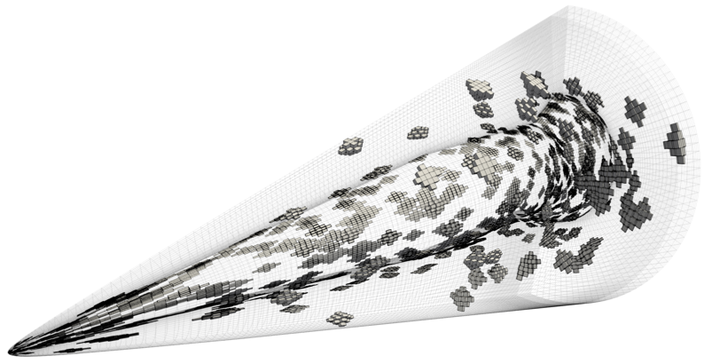Model reduction for hypersonic aerodynamics via conservative LSPG projection and hyper-reduction
 Sample mesh. The residual is sampled at 813 randomly selected cells (0.04% of all cells), requiring 19901 total cells (0.98% of all cells) to keep neighbor cells and neighbors of neighbors.
Sample mesh. The residual is sampled at 813 randomly selected cells (0.04% of all cells), requiring 19901 total cells (0.98% of all cells) to keep neighbor cells and neighbors of neighbors.Abstract
High-speed aerospace engineering applications rely heavily on computational fluid dynamics (CFD) models for design and analysis due to the expense and difficulty of flight tests and experiments. This reliance on CFD models necessitates performing accurate and reliable uncertainty quantification (UQ) of the CFD models. However, it is very computationally expensive to run CFD for hypersonic flows due to the fine grid resolution required to capture the strong shocks and large gradients that are typically present. Additionally, UQ approaches are many-query problems requiring many runs with a wide range of input parameters. One way to enable computationally expensive models to be used in such many-query problems is to employ projection-based reduced-order models (ROMs) in lieu of the (high-fidelity) full-order model. In particular, the least-squares Petrov–Galerkin (LSPG) ROM (equipped with hyper-reduction) has demonstrated the ability to significantly reduce simulation costs while retaining high levels of accuracy on a range of problems including subsonic CFD applications [1, 2]. This allows computationally inexpensive LSPG ROM simulations to replace the full-order model simulations in UQ studies, which makes this many-query task tractable, even for large-scale CFD models. This work presents the first application of LSPG to a hypersonic CFD application. In particular, we present results for LSPG ROMs of the HIFiRE-1 in a three-dimensional, turbulent Mach 7.1 flow, showcasing the ability of the ROM to significantly reduce computational costs while maintaining high levels of accuracy in computed quantities of interest.